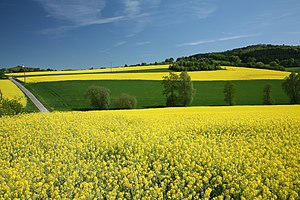Colza oil or Rapeseed oil is a nondrying oilobtained from the seeds of Rapeseed(Brassica napus subsp. napus.[1] syn. Brassica napus var. oleifera Delile, Brassica campestrissubsp. napus (L.) Hook.f. & T.Anderson.)[2]Colza is extensively cultivated in France, Belgium, the United States, the Netherlands, Germany and Poland. In France, especially, the extraction of the oil is an important industry. In commerce, colza is a traditional rapeseed oil(with turnip rape oil, sarson oil, toria oil (Brassica rapa ssp.), and ravison oil),[3] to which they are very closely allied in both source and properties. It is a comparatively nonodoriferous oil of a yellow colour, having a specific gravity varying between 0.912 and 0.920. The cake left after extraction of the oil is a valuable feed ingredient for pigs.

Uses
See also
References

Colza cultivation in Germany
Uses
Colza oil is extensively used as a lubricant for machinery.
Colza oil was used extensively in European domestic lighting before the advent of coal (city) gas or kerosene. It was the preferred oil for train pot lamps, and was used for lighting railway coaches in the United Kingdom before gas lighting, and later electric lighting, were adopted. Burned in a Carcel lamp, it was part of the definition of the French standard measure for illumination, the carcel, for most of the nineteenth century. In lighthouses, for example in early Canada, colza oil was used before the introduction of mineral oil. The colza oil was used with the Argand burner because it was cheaper than whale oil.[4] Colza was burned to a limited extent in the Confederacy during the American Civil War.[5]
Colza oil was used in Gombault's Caustic Balsam,[6] a popular horse and human liniment at the turn of the 20th century. (Note that the ingredients listed in this link are similar to, but not the same as, the list on the actual bottle).
Among the more unusual applications of colza oil is the calming of choppy seas, where the oil modifies the surface tension of the water and rapidly smooths the surface. For this purpose, colza oil was carried in ship's lifeboats. Rescue and recovery operations have been made far less risky in this way.[7]
More recently, colza has been cultivated in Europe as an ingredient for biodiesel fuels, and is the primary source of biodiesel in Germany.
See also
- Toxic Oil Syndrome
- canola, a low erucic acid rapeseed oil
References
 This article incorporates text from a publication now in the public domain: Chisholm, Hugh, ed. (1911). "article name needed". Encyclopædia Britannica (11th ed.). Cambridge University Press.
This article incorporates text from a publication now in the public domain: Chisholm, Hugh, ed. (1911). "article name needed". Encyclopædia Britannica (11th ed.). Cambridge University Press.
- ^ Vegetable substances: materials of manufactures, Society for the Diffusion of Useful Knowledge, 1833, p. 204-205
- ^ Ref. GRIN
- ^ Jan Velíšek, "colza" The Chemistry of Food, Wiley, 2014, p. 102
- ^ "USQUE AD MARE - Early Lights - Canadian Coast Guard". Ccg-gcc.gc.ca. 2008-03-31. Retrieved 2010-03-14.
- ^ Mallett, John W. "How the South got chemicals during the war". Southern Historical Society Papers 31: 101.
- ^ "Gombaults". Racehorseherbal.com. Retrieved 2010-03-14.
- ^ "Oil Tested in Storms at Sea". New York Times. 1893-03-04. Retrieved 2010-03-14.
Wikipedia





No comments:
Post a Comment